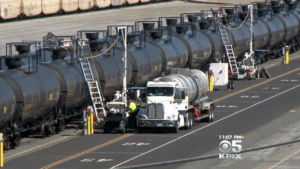Dakota Access Pipeline Already a Huge Success, Close to Capacity
Hard to believe that’s it’s already been about a year since the Dakota Access Pipeline protests petered out next door in North Dakota. Instead of coddling activists who trashed the land like his predecessor, President Trump ordered the US Army Corps of Engineers to expedite DAPL, a $3.8 billion project destined to bring the country to the brink of energy self-sufficiency with Bakken crude.

So how’s it going? An update in the Bismarck Tribune reveals the pipeline currently runs at an estimated 86 percent capacity with plans to expand shipments on what’s called the Bakken Pipeline System.
The company that built the Dakota Access Pipeline is gauging the oil industry’s interest in shipping additional oil from the Bakken to the Gulf Coast.
Energy Transfer Partners recently announced it is soliciting commitments from the industry to expand the capacity of the four-state Dakota Access Pipeline and the Energy Transfer Crude Oil Pipeline, which transports oil from Illinois to Nederland, Texas.
In June, Energy Transfer Partners said in a news release the Dakota Access Pipeline from North Dakota to Illinois had a capacity of 520,000 barrels per day and could be expanded up to 570,000 barrels per day.
In fact, thanks to fracking, oil production in North Dakota continues to set to new records. DAPL may run out of room before long.
North Dakota produced about 1.18 million barrels of oil per day in December, the most recent figure available. Production is soon expected to exceed the state’s record of more than 1.2 million barrels a day and continue growing.
Kringstad projects that oil production could exceed the state’s pipeline capacity in 12 to 18 months.
“I would say there’s going to be strong interest in additional transportation out of the region,” he said.

Yet one important safety issue often gets overlooked-the thousands of Warren Buffet’s rail cars that no longer rumble through and present a potential hazard to countless towns and cities, thanks to DAPL. Studies show modern underground pipelines are far safer for people and the environment than oil rail cars and trucks. Given that reality, you have to wonder why the Standing Rock Sioux Reservation still apparently allows rail cars to cross its land transporting crude from the tribe’s own wells.